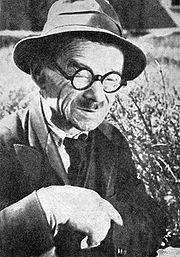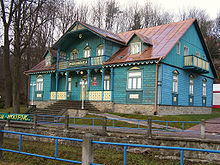
Nykifor
Encyclopedia

Ukraine
Ukraine is a country in Eastern Europe. It has an area of 603,628 km², making it the second largest contiguous country on the European continent, after Russia...
folk
Folk art
Folk art encompasses art produced from an indigenous culture or by peasants or other laboring tradespeople. In contrast to fine art, folk art is primarily utilitarian and decorative rather than purely aesthetic....
and naïve
Naïve art
Naïve art is a classification of art that is often characterized by a childlike simplicity in its subject matter and technique. While many naïve artists appear, from their works, to have little or no formal art training, this is often not true...
painter of Lemko descent. Nikifor painted over 40,000 pictures - on sheets of paper, pages of notebooks, cigarette cartons, and even on scraps of paper glued together. The topics of his art include self-portraits and panoramas of Krynica, with its spas and Orthodox and Catholic churches. Underestimated for most of his life, in his late days he became famous as a primitivist
Primitivism
Primitivism is a Western art movement that borrows visual forms from non-Western or prehistoric peoples, such as Paul Gauguin's inclusion of Tahitian motifs in paintings and ceramics...
painter.
Biography

Palate
The palate is the roof of the mouth in humans and other mammals. It separates the oral cavity from the nasal cavity. A similar structure is found in crocodilians, but, in most other tetrapods, the oral and nasal cavities are not truly separate. The palate is divided into two parts, the anterior...
, which was the reason why his speech was unintelligible to most. In 1930 his first paintings were discovered by Roman Turyn, who brought them to Paris. That made Nikifor gain some fame among the Kapists
Kapists
Kapists or KPists , also known as the Colourists, were a group of Polish painters of 1930s who dominated the Polish artistic landscape of the epoch...
, a group of young painters formed around Józef Pankiewicz
Józef Pankiewicz
Józef Pankiewicz was a Polish painter, graphic artist, and pedagogue.Pankiewicz was born at Lublin. He studied under Wojciech Gerson and Alexander Kamiński. He travelled to Saint Petersburg with Władysław Podkowiński after winning a scholarship to the Imperial Academy of Arts there...
. However, this did not change his fate as his art was still being underestimated in Poland. In 1938 Jerzy Wolff published an enthusiastic review of Nikifor's art in Arkady monthly and bought some of his works. However, the war
World War II
World War II, or the Second World War , was a global conflict lasting from 1939 to 1945, involving most of the world's nations—including all of the great powers—eventually forming two opposing military alliances: the Allies and the Axis...
prevented Nikifor from gaining any notoriety.
In 1947 Nikifor was deported during Operation Vistula. The Lemko and Ukrainian minorities were resettled with force in northern and western Poland. Three times he attempted to return to Krynica. He was actually very lucky that the authorities allowed him to stay the third time, as other Lemko and Ukrainian people who tried to return to their native villages were deported to the concentration camp in Jaworzno.
In 1960 Nikifor met Marian Włosiński, a painter living in Krynica. The latter decided to devote his career and life to helping the elderly artist and promoted his works in major galleries of Poland. This led to a large exhibition in the Warsaw-based Zachęta
Zacheta
The Zachęta National Gallery of Art, short Zachęta, , is one of Poland's most notable institutions for contemporary art. Situated in the centre of Warsaw, the main aim of the gallery is to present and support primarily Polish contemporary art and artists...
Art Gallery, which became a huge success. After the death of Nikifor in 1968, most of his works were preserved by Włosiński and donated to various museums. The most complete collection is stored in the Regional Museum of Nowy Sącz
Nowy Sacz
Nowy Sącz is a town in the Lesser Poland Voivodeship in southern Poland. It is the district capital of Nowy Sącz County, but is not included within the powiat.-Names:...
and the Krynica-based museum of Nikifor.
The last years of Nikifor have been the basic theme of the 2004 film Mój Nikifor (My Nikifor) by Krzysztof Krauze
Krzysztof Krauze
Krzysztof Krauze is a Polish film director, screenwriter, photographer and cinematographer from Warsaw best known for his 1999 film thriller Debt....
, featuring actress Krystyna Feldman
Krystyna Feldman
Krystyna Feldman was a Polish actress.-Life and career:Born in Lemberg, Austria-Hungary to a Catholic mother, Katarzyna Sawicka-Feldman, an opera singer and a Jewish father, Ferdynand Feldman, an actor, Feldman identified with Catholicism...
in the role of the artist.

Name
The name and surname of Nikifor have been a matter of dispute for over half a century now, as he had no known relatives or documents, and was almost illiterate. He signed his works with the names Nikifor, Netyfor or MatejkoJan Matejko
Jan Matejko was a Polish painter known for paintings of notable historical Polish political and military events. His most famous works include oil on canvas paintings like Battle of Grunwald, paintings of numerous other battles and court scenes, and a gallery of Polish kings...
. In 1962 the communist authorities in Poland arbitrarily chose the name Nikifor Krynicki (Nikifor of Krynica, after his place of residence) so that a passport
Passport
A passport is a document, issued by a national government, which certifies, for the purpose of international travel, the identity and nationality of its holder. The elements of identity are name, date of birth, sex, and place of birth....
could be issued for him. This act was declared null by a court in 2003, following a statement by the Lemko Association of Poland. The court idenrtified the documents which stated that Nikifor was baptized Epifaniy Drovnyak (spelled Epifaniusz Drowniak in Polish) and his mother was Eudokia Drowniak, a Lemko woman. Following the court's ruling the name on his grave in Krynica cemetery was changed. Currently his tombstone bears two names: "Nikifor Krynicki" in Latin letters and "Epifaniy Drovnyak" in Cyrillic letters.

